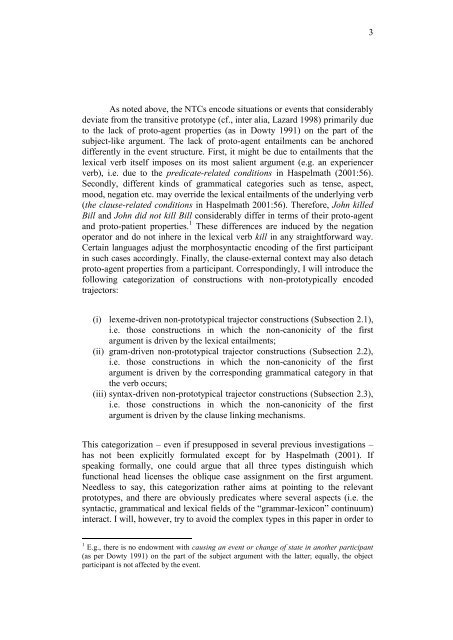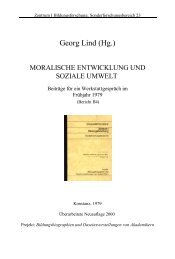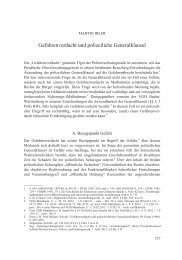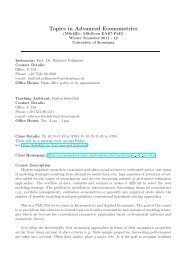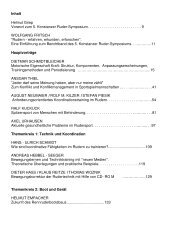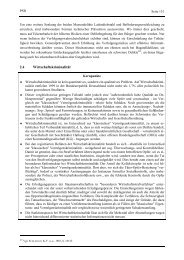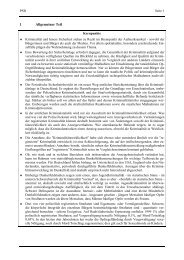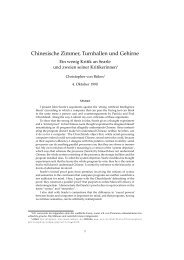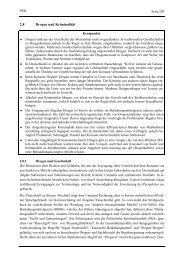Subjects and non-subjects in constructions
Subjects and non-subjects in constructions
Subjects and non-subjects in constructions
You also want an ePaper? Increase the reach of your titles
YUMPU automatically turns print PDFs into web optimized ePapers that Google loves.
3<br />
As noted above, the NTCs encode situations or events that considerably<br />
deviate from the transitive prototype (cf., <strong>in</strong>ter alia, Lazard 1998) primarily due<br />
to the lack of proto-agent properties (as <strong>in</strong> Dowty 1991) on the part of the<br />
subject-like argument. The lack of proto-agent entailments can be anchored<br />
differently <strong>in</strong> the event structure. First, it might be due to entailments that the<br />
lexical verb itself imposes on its most salient argument (e.g. an experiencer<br />
verb), i.e. due to the predicate-related conditions <strong>in</strong> Haspelmath (2001:56).<br />
Secondly, different k<strong>in</strong>ds of grammatical categories such as tense, aspect,<br />
mood, negation etc. may override the lexical entailments of the underly<strong>in</strong>g verb<br />
(the clause-related conditions <strong>in</strong> Haspelmath 2001:56). Therefore, John killed<br />
Bill <strong>and</strong> John did not kill Bill considerably differ <strong>in</strong> terms of their proto-agent<br />
<strong>and</strong> proto-patient properties. 1 These differences are <strong>in</strong>duced by the negation<br />
operator <strong>and</strong> do not <strong>in</strong>here <strong>in</strong> the lexical verb kill <strong>in</strong> any straightforward way.<br />
Certa<strong>in</strong> languages adjust the morphosyntactic encod<strong>in</strong>g of the first participant<br />
<strong>in</strong> such cases accord<strong>in</strong>gly. F<strong>in</strong>ally, the clause-external context may also detach<br />
proto-agent properties from a participant. Correspond<strong>in</strong>gly, I will <strong>in</strong>troduce the<br />
follow<strong>in</strong>g categorization of <strong>constructions</strong> with <strong>non</strong>-prototypically encoded<br />
trajectors:<br />
(i) lexeme-driven <strong>non</strong>-prototypical trajector <strong>constructions</strong> (Subsection 2.1),<br />
i.e. those <strong>constructions</strong> <strong>in</strong> which the <strong>non</strong>-ca<strong>non</strong>icity of the first<br />
argument is driven by the lexical entailments;<br />
(ii) gram-driven <strong>non</strong>-prototypical trajector <strong>constructions</strong> (Subsection 2.2),<br />
i.e. those <strong>constructions</strong> <strong>in</strong> which the <strong>non</strong>-ca<strong>non</strong>icity of the first<br />
argument is driven by the correspond<strong>in</strong>g grammatical category <strong>in</strong> that<br />
the verb occurs;<br />
(iii) syntax-driven <strong>non</strong>-prototypical trajector <strong>constructions</strong> (Subsection 2.3),<br />
i.e. those <strong>constructions</strong> <strong>in</strong> which the <strong>non</strong>-ca<strong>non</strong>icity of the first<br />
argument is driven by the clause l<strong>in</strong>k<strong>in</strong>g mechanisms.<br />
This categorization – even if presupposed <strong>in</strong> several previous <strong>in</strong>vestigations –<br />
has not been explicitly formulated except for by Haspelmath (2001). If<br />
speak<strong>in</strong>g formally, one could argue that all three types dist<strong>in</strong>guish which<br />
functional head licenses the oblique case assignment on the first argument.<br />
Needless to say, this categorization rather aims at po<strong>in</strong>t<strong>in</strong>g to the relevant<br />
prototypes, <strong>and</strong> there are obviously predicates where several aspects (i.e. the<br />
syntactic, grammatical <strong>and</strong> lexical fields of the “grammar-lexicon” cont<strong>in</strong>uum)<br />
<strong>in</strong>teract. I will, however, try to avoid the complex types <strong>in</strong> this paper <strong>in</strong> order to<br />
1 E.g., there is no endowment with caus<strong>in</strong>g an event or change of state <strong>in</strong> another participant<br />
(as per Dowty 1991) on the part of the subject argument with the latter; equally, the object<br />
participant is not affected by the event.


